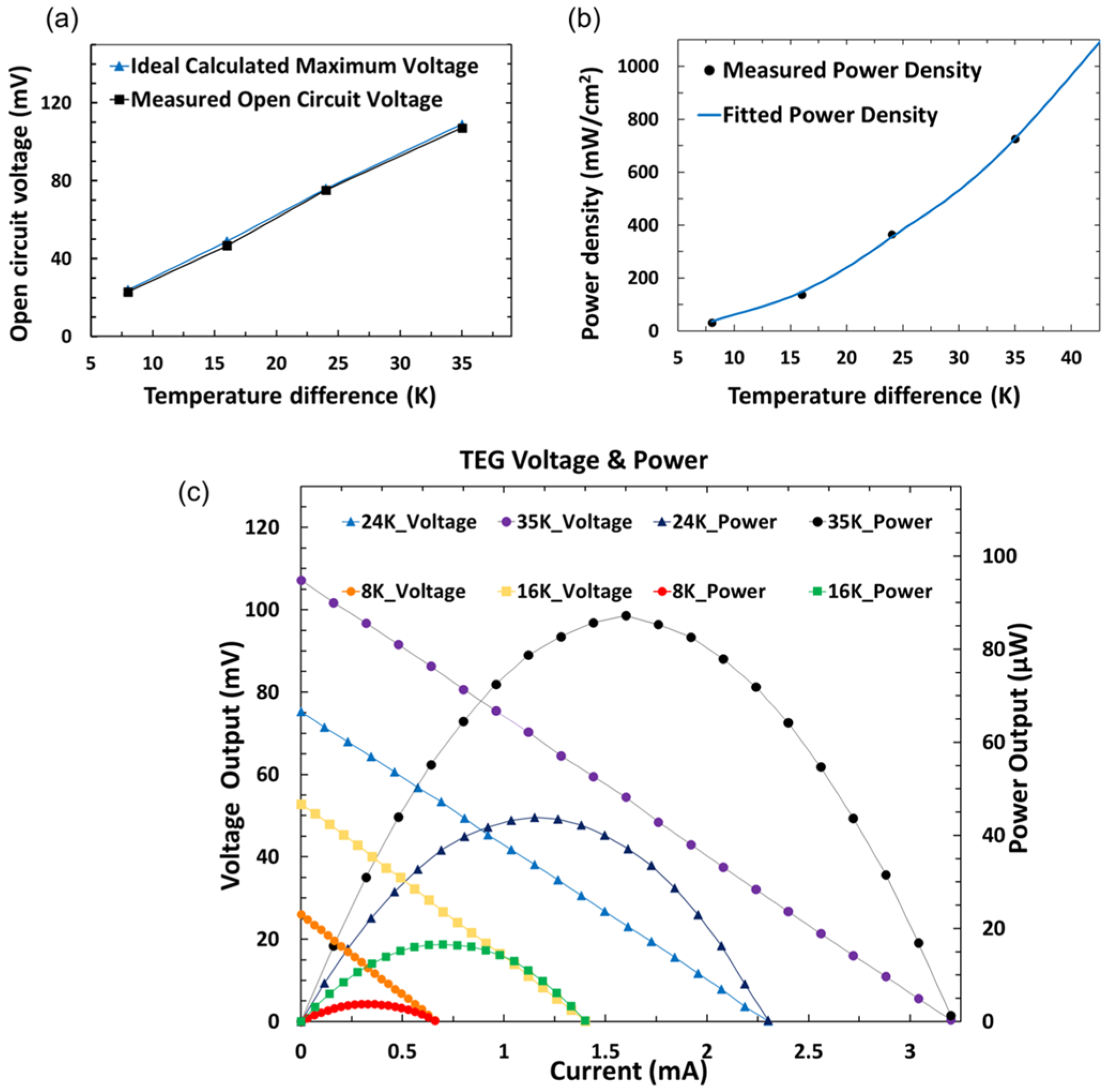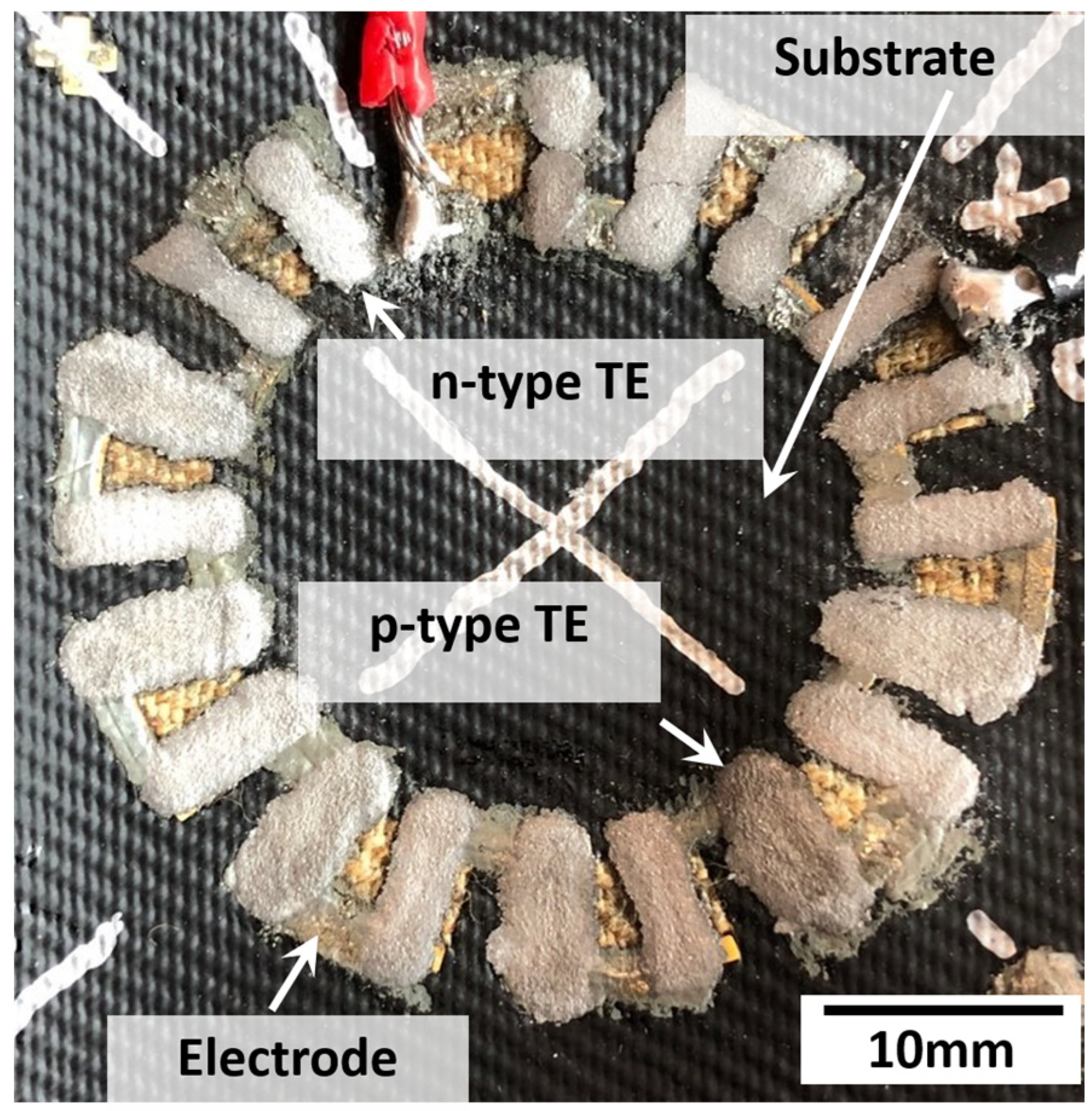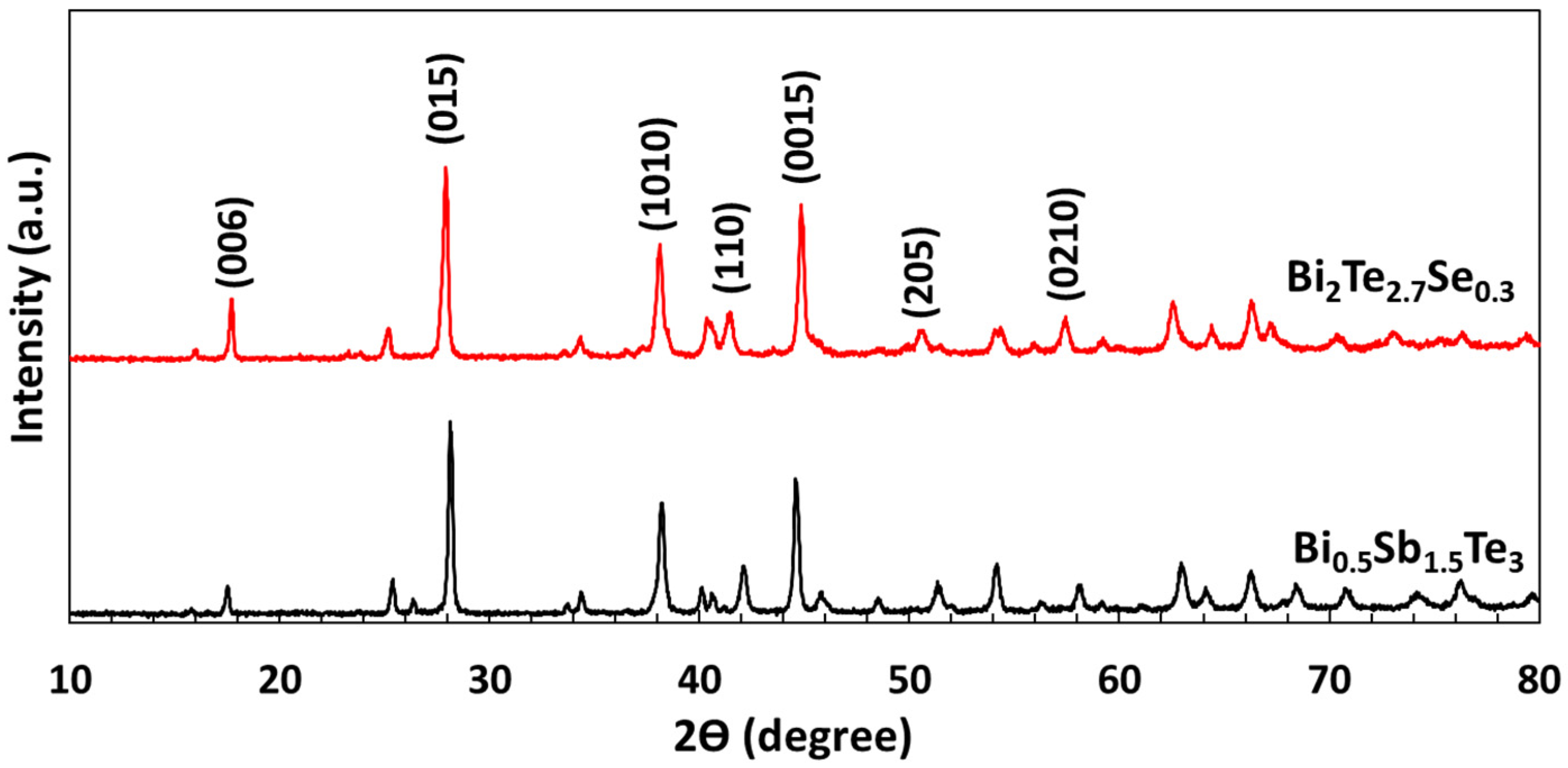Stencil-Printed Scalable Radial Thermoelectric Device Using Sustainable Manufacturing Methods
Abstract
:1. Introduction
2. Experimental Method
2.1. TE Film Fabrication and Measurements
2.2. TEG Prototype Fabrication
2.3. TEG Prototype Characterization
3. Results and Discussion
3.1. XRD Characterization
3.2. TE Composite Films Characterization at High Temperature
3.3. Radial TEG Prototype Power Output Characterizations

| Number of Couples | Dimensions | Resistance (Ω) | ΔT (K) | Max. Voltage (mV) | Max. Power (μW) | Power Density (μW/cm2) | Curing Temp (K) | Max. Curing Time (min) | Reference |
|---|---|---|---|---|---|---|---|---|---|
| 10 | 20 mm × 20 mm × 70 µm | 192 | 48 | 68 | 6 | 238 | 523 | 480 | [16] |
| 5 × 10 planar | 3.5 mm × 0.6 mm × 100 µm | 55 | 20 | 88 | 33 | 280 | 523 | 180 | [20] |
| 4 single leg | 10 mm × 2.7 mm × 27 µm | 8.5 | 80 | 60 | 54 | 1880 | 723 | 136 | [23] |
| 10 circular | 5 mm × 1.5 mm × 120 µm | 100 | 70 | 230 | 130 | 1230 | 523 | 360 | [25] |
| 9 planar | 6.5 mm × 2.3 mm × 150 µm | 12 | 40 | 54 | 73 | 566 | 393 | 60 | [36] |
| 2 single legs | 6 mm × 3 mm × 170 µm | 9 | 12 | 4.2 | 0.48 | 393 | 30 | [37] | |
| 3 single legs | 5 mm × 7 mm × 70 µm | 3 | 38 | 20 | 58 | 5720 | 423 | 30 | [38] |
| 6 | 7 mm × 3 mm × 170 µm | 5.9 | 40 | 90 | 357 | 5000 | 423 | 30 | [39] |
| 24 | 40 mm × 80 mm × 300 µm | 1600 | 35 | 10 | 0.015 | - | 393 | 30 | [40] |
| 7.5 radial | 7 mm × 2.5 mm × 160 µm | 37 | 34 | 110 | 87 | 727 | 393 | 60 | This work |
4. Conclusions
Author Contributions
Funding
Informed Consent Statement
Data Availability Statement
Acknowledgments
Conflicts of Interest
References
- Filipponi, L.; Vitaletti, A.; Landi, G.; Memeo, V.; Laura, G.; Pucci, P. Smart City: An event driven architecture for monitoring public spaces with heterogeneous sensors. In Proceedings of the Fourth International Conference on Sensor Technologies and Applications, SensorComm 2010, Venice, Italy, 18–25 July 2010; IEEE Computer Society: Washington, DC, USA, 2010; pp. 281–286. [Google Scholar]
- Kocakulak, M.; Butun, I. An overview of Wireless Sensor Networks towards internet of things. In Proceedings of the IEEE 7th Annual Computing and Communication Workshop and Conference (CCWC) 2017, Las Vegas, NV, USA, 9–11 January 2017; 2017; pp. 1–6. [Google Scholar]
- Lazarescu, M.T. Design of a WSN platform for long-term environmental monitoring for IoT applications. IEEE J. Emerg. Sel. Top. Circuits Syst. 2013, 3, 45–54. [Google Scholar] [CrossRef]
- Akhtar, F.; Rehmani, M.H. Energy replenishment using renewable and traditional energy resources for sustainable wireless sensor networks: A review. Renew. Sustain. Energy Rev. 2015, 45, 769–784. [Google Scholar] [CrossRef]
- Guan, M.; Wang, K.; Xu, D.; Liao, W.H. Design and experimental investigation of a low-voltage thermoelectric energy harvesting system for wireless sensor nodes. Energy Convers. Manag. 2017, 138, 30–37. [Google Scholar] [CrossRef]
- Baldwin, R.; Bobovych, S.; Robucci, R.; Patel, C.; Banerjee, N. Gait analysis for fall prediction using hierarchical textile-based capacitive sensor arrays. In Proceedings of the 2015 Design, Automation & Test in Europe Conference & Exhibition 2015, Grenoble, France, 9–13 March 2015; EDA Consortium: San Jose, CA, USA, 2015; pp. 1293–1298. [Google Scholar]
- Chee, Y.-H.; Koplow, M.; Mark, M.; Pletcher, N.; Seeman, M.; Burghardt, F.; Steingart, D.; Rabaey, J.; Wright, P.; Sanders, S. PicoCube: A 1 cm3 sensor node powered by harvested energy. In Proceedings of the DAC 0‘8: The 45th Annual Design Automation Conference 2008, Anaheim, CA, USA, 8–13 June 2008; Association for Computing Machinery: New York, NY, USA, 2008; pp. 114–119. [Google Scholar]
- Milenković, A.; Otto, C.; Jovanov, E. Wireless sensor networks for personal health monitoring: Issues and an implementation. Comput. Commun. 2006, 29, 2521–2533. [Google Scholar] [CrossRef]
- Roundy, S.; Wright, P.K.; Rabaey, J. A study of low level vibrations as a power source for wireless sensor nodes. Comput. Commun. 2003, 26, 1131–1144. [Google Scholar] [CrossRef]
- Poudel, B.; Hao, Q.; Ma, Y.; Lan, Y.; Minnich, A.; Yu, B.; Yan, X.; Wang, D.; Muto, A.; Vashaee, D.; et al. High-thermoelectric performance of nanostructured bismuth antimony telluride bulk alloys. Science 2008, 320, 634–638. [Google Scholar] [CrossRef] [PubMed]
- Bell, L.E. Cooling, heating, generating power, and recovering waste heat with thermoelectric systems. Science 2008, 321, 1457–1461. [Google Scholar] [CrossRef]
- Park, S.H.; Jo, S.; Kwon, B.; Kim, F.; Ban, H.W.; Lee, J.E.; Gu, D.H.; Lee, S.H.; Hwang, Y.; Kim, J.-S.; et al. High-performance shape-engineerable thermoelectric painting. Nat. Commun. 2016, 7, 13403. [Google Scholar] [CrossRef]
- Park, J.W.; Kim, C.S.; Choi, H.; Kim, Y.J.; Lee, G.S.; Cho, B.J. A Flexible Micro-Thermoelectric Generator Sticker with Trapezoidal-Shaped Legs for Large Temperature Gradient and High-Power Density. Adv. Mater. Technol. 2020, 5, 2000486. [Google Scholar] [CrossRef]
- Kim, F.; Kwon, B.; Eom, Y.; Lee, J.E.; Park, S.; Jo, S.; Park, S.H.; Kim, B.S.; Im, H.J.; Lee, M.H.; et al. 3D printing of shape-conformable thermoelectric materials using all-inorganic Bi2Te3-based inks. Nat. Energy 2018, 3, 301–309. [Google Scholar] [CrossRef]
- Liu, K.; Tang, X.; Liu, Y.; Xu, Z.; Yuan, Z.; Zhang, Z. Enhancing the performance of fully-scaled structure-adjustable 3D thermoelectric devices based on cold–press sintering and molding. Energy 2020, 206, 118096. [Google Scholar] [CrossRef]
- Yuan, Z.; Tang, X.; Xu, Z.; Li, J.; Chen, W.; Liu, K.; Liu, Y.; Zhang, Z. Screen-printed radial structure micro radioisotope thermoelectric generator. Appl. Energy 2018, 225, 746–754. [Google Scholar] [CrossRef]
- Jang, E.; Poosapati, A.; Jang, N.; Hu, L.; Duffy, M.; Zupan, M.; Madan, D. Thermoelectric properties enhancement of p-type composite films using wood-based binder and mechanical pressing. Sci. Rep. 2019, 9, 7869. [Google Scholar] [CrossRef]
- Glatz, W.; Muntwyler, S.; Hierold, C. Optimization and fabrication of thick flexible polymer based micro thermoelectric generator. Sens. Actuators A Phys. 2006, 132, 337–345. [Google Scholar] [CrossRef]
- Tanwar, A.; Lal, S.; Razeeb, K.M. Structural design optimization of micro-thermoelectric generator for wearable biomedical devices. Energies 2021, 14, 2339. [Google Scholar] [CrossRef]
- Madan, D.; Wang, Z.; Wright, P.K.; Evans, J.W. Printed flexible thermoelectric generators for use on low levels of waste heat. Appl. Energy 2015, 156, 587–592. [Google Scholar] [CrossRef]
- Choi, H.; Kim, S.J.; Kim, Y.; We, J.H.; Oh, M.W.; Cho, B.J. Enhanced thermoelectric properties of screen-printed Bi0.5Sb1.5Te3 and Bi2Te2.7Se0.3 thick films using a post annealing process with mechanical pressure. J. Mater. Chem. C 2017, 5, 8559–8565. [Google Scholar] [CrossRef]
- Kim, S.J.; We, J.H.; Cho, B.J. A wearable thermoelectric generator fabricated on a glass fabric. Energy Environ. Sci. 2014, 7, 1959–1965. [Google Scholar] [CrossRef]
- Varghese, T.; Dun, C.; Kempf, N.; Saeidi-Javash, M.; Karthik, C.; Richardson, J.; Hollar, C.; Estrada, D.; Zhang, Y. Flexible thermoelectric devices of ultrahigh power factor by scalable printing and interface engineering. Adv. Funct. Mater. 2019, 30, 1905796. [Google Scholar] [CrossRef]
- Choi, H.; Kim, Y.J.; Kim, C.S.; Yang, H.M.; Oh, M.W.; Cho, B.J. Enhancement of reproducibility and reliability in a high-performance flexible thermoelectric generator using screen-printed materials. Nano Energy 2018, 46, 39–44. [Google Scholar] [CrossRef]
- Madan, D.; Wang, Z.; Chen, A.; Winslow, R.; Wright, P.K.; Evans, J.W. Dispenser printed circular thermoelectric devices using Bi and Bi0.5Sb1.5Te3. Appl. Phys. Lett. 2014, 104, 013902. [Google Scholar] [CrossRef]
- Huang, J.; Li, H.; Kirksey, E.; Hoffman, C.; Jang, H.J.; Wagner, J.; Madan, D.; Katz, H.E. Promising Thermoelectric Properties of Commercial PEDOT: PSS Materials and their Bi2Te3 Powder Composites. J. Appl. Phys. 2019, 125, 125502. [Google Scholar] [CrossRef]
- Hossain, M.S.; Li, T.; Yu, Y.; Yong, J.; Bahkb, J.H.; Skafidasa, E. Recent advances in printable thermoelectric devices: Materials, printing techniques, and applications. RSC Adv. 2020, 10, 8421. [Google Scholar] [CrossRef]
- Zhang, B.; Sun, J.; Katz, H.E.; Fang, F.; Opila, R.L. Promising thermoelectric properties of commercial PEDOT:PSS materials and their Bi2Te3 powder composites. ACS Appl. Mater. Interfaces 2010, 2, 3170–3178. [Google Scholar] [CrossRef]
- Zeng, M.; Zavanelli, D.; Chen, J.; Javash, M.S.; Du, Y.; LeBlanc, S.; Snyder, G.J.; Zhang, Y. Printing thermoelectric inks toward next-generation energy and thermal devices. Chem. Soc. Rev. 2022, 51, 485–512. [Google Scholar] [CrossRef]
- Byun, S.H.; Kim, C.S.; Agno, K.-C.; Lee, S.; Li, Z.; Cho, B.J.; Jeong, J.-W. Design strategy for transformative electronic system toward rapid, bidirectional stiffness tuning using graphene and flexible thermoelectric device interfaces. Adv. Mater. 2021, 33, 2170076. [Google Scholar] [CrossRef]
- Lv, H.; Liang, L.; Zhang, Y.; Deng, L.; Chen, Z.; Liu, Z.; Wang, H.; Chen, G. A flexible spring-shaped architecture with optimized thermal design for wearable thermoelectric energy harvesting. Nano Energy 2021, 88, 106260. [Google Scholar] [CrossRef]
- Wang, X.; Liang, L.; Lv, H.; Zhang, Y.; Chen, G. Elastic aerogel thermoelectric generator with vertical temperature-difference architecture and compression-induced power enhancement. Nano Energy 2021, 90, 106577. [Google Scholar] [CrossRef]
- Liu, L.; Chen, J.; Liang, L.; Deng, L.; Chen, G. A PEDOT:PSS thermoelectric fiber generator. Nano Energy 2022, 102, 107678. [Google Scholar] [CrossRef]
- Du, C.; Cao, M.; Li, G.; Hu, Y.; Zhang, Y.; Liang, L.; Liu, Z.; Chen, G. Toward Precision Recognition of Complex Hand Motions: Wearable Thermoelectrics by Synergistic 2D Nanostructure Confinement and Controlled Reduction. Adv. Funct. Mater. 2022, 32, 2206083. [Google Scholar] [CrossRef]
- Li, G.; Hu, Y.; Chen, J.; Liang, L.; Liu, Z.; Fu, J.; Du, C.; Chen, G. Thermoelectric and Photoelectric Dual Modulated Sensors for Human Internet of Things Application in Accurate Fire Recognition and Warning. Adv. Funct. Mater. 2023, 33, 2303861. [Google Scholar] [CrossRef]
- Jang, E.; Banerjee, P.; Huang, J.; Madan, D. High performance scalable and cost-effective thermoelectric devices fabricated using energy efficient methods and naturally occurring materials. Appl. Energy 2021, 294, 117006. [Google Scholar] [CrossRef]
- Banerjee, P.; Jang, E.; Huang, J.; Holley, R.; Vadnala, S.; Sheikh, A.; Trivedi, A.; Jackson, K.; Homman, V.K.; Madan, D. Thermoelectric performance enhancement of n-type chitosan-Bi2Te2.7Se0.3 composite films using heterogeneous grains and mechanical pressure. J. Electron. Mater. 2021, 50, 2840–2851. [Google Scholar] [CrossRef]
- Banerjee, P.; Huang, J.; Ambade, R.B.; Jang, E.; Saeidi-Javash, M.; Zhang, Y.; Madan, D. Effect of particle-size distribution and pressure-induced densification on the microstructure and properties of printable thermoelectric composites and high energy density flexible devices. Nano Energy 2021, 89, 106482. [Google Scholar] [CrossRef]
- Huang, J.; Ambade, R.B.; Lombardo, J.; Brooks, B.; Poosapati, A.; Banerjee, P.; Javash, M.S.; Zhang, Y.; Madan, D. Energy Density Enhancement of Scalable Thermoelectric Devices Using a Low Thermal Budget Method with Film Thickness Variation. Appl. Mater. Today 2024, 37, 102116. [Google Scholar] [CrossRef]
- Lu, Z.; Zhang, H.; Mao, C.; Li, C.M. Silk fabric-based wearable thermoelectric generator for energy harvesting from the human body. Appl. Energy 2016, 164, 57–63. [Google Scholar] [CrossRef]
- Mamur, H.; Dilmaç, O.F.; Begum, J.; Bhuiyan, M.R.A. Thermoelectric generators act as renewable energy sources. Clean. Mater. 2021, 2, 100030. [Google Scholar] [CrossRef]



Disclaimer/Publisher’s Note: The statements, opinions and data contained in all publications are solely those of the individual author(s) and contributor(s) and not of MDPI and/or the editor(s). MDPI and/or the editor(s) disclaim responsibility for any injury to people or property resulting from any ideas, methods, instructions or products referred to in the content. |
© 2024 by the authors. Licensee MDPI, Basel, Switzerland. This article is an open access article distributed under the terms and conditions of the Creative Commons Attribution (CC BY) license (https://creativecommons.org/licenses/by/4.0/).
Share and Cite
Jang, E.; Ambade, R.B.; Banerjee, P.; Topoleski, L.D.T.; Madan, D. Stencil-Printed Scalable Radial Thermoelectric Device Using Sustainable Manufacturing Methods. Sustainability 2024, 16, 3560. https://doi.org/10.3390/su16093560
Jang E, Ambade RB, Banerjee P, Topoleski LDT, Madan D. Stencil-Printed Scalable Radial Thermoelectric Device Using Sustainable Manufacturing Methods. Sustainability. 2024; 16(9):3560. https://doi.org/10.3390/su16093560
Chicago/Turabian StyleJang, Eunhwa, Rohan B. Ambade, Priyanshu Banerjee, L. D. Timmie Topoleski, and Deepa Madan. 2024. "Stencil-Printed Scalable Radial Thermoelectric Device Using Sustainable Manufacturing Methods" Sustainability 16, no. 9: 3560. https://doi.org/10.3390/su16093560






